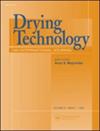单宁酸交联羟基磷灰石/明胶复合材料的喷雾干燥载药及动力学研究
IF 2.7
3区 工程技术
Q3 ENGINEERING, CHEMICAL
引用次数: 0
摘要
摘要本研究旨在研究羟基磷灰石/明胶(HAp-GEL)复合材料对5-氟尿嘧啶(5-FU)药物的负载与释放。在pH 7.4和37°C的模拟体液(SBF)存在下,以单宁酸(TA)为交联剂制备复合材料。采用x射线衍射、热重分析、傅里叶变换红外光谱和扫描电镜对HAp-GEL复合材料进行了表征。通过喷雾干燥机将5-FU包封在HAp-GEL复合材料上。药物释放动力学研究表明,HAp-GEL复合材料的5-FU释放最符合一级动力学模型,R2在0.85 ~ 0.98范围内。明胶和TA含量对复合材料的释放曲线和初始爆裂值有影响,明胶含量越高,初始爆裂值越高。在生理pH(7.4)条件下,制备的HAp-GEL复合材料的5-FU释放量较高。目前的研究表明,制备的负载5-FU的HAp-GEL复合材料具有作为5-FU药物载体的临床应用潜力。关键词:羟基磷灰石胶丁酸聚合物复合材料披露声明作者报告无利益冲突。作者独自负责论文的内容和写作。附加信息:贡献者说明1。GumusI。B. Gumus于2018年在土耳其伊斯坦布尔工业大学化学工程系完成硕士论文。KahramanE。Kahraman于2023年在土耳其伊斯坦布尔技术大学化学工程系获得博士学位,目前担任研究助理。Erdol-AydinN。埃尔多-艾丁是土耳其伊斯坦布尔技术大学化学工程系副教授。Nasun-SaygiliG。Nasun-Saygili是土耳其伊斯坦布尔技术大学化学工程系的教授。本文章由计算机程序翻译,如有差异,请以英文原文为准。
Drug loading of tannic acid crosslinked hydroxyapatite/gelatin composites via spray dryer and kinetic studies
AbstractThe present study aims at studying the loading and release of 5-Fluorouracil (5-FU) drug from hydroxyapatite/gelatin (HAp-GEL) composites. Composites were produced in the presence of simulated body fluid (SBF) at pH 7.4 and 37 °C implementing tannic acid (TA) as a cross-linking agent. HAp-GEL composites were characterized by X-ray diffraction, thermogravimetric analysis, Fourier transform infrared spectroscopy and scanning electron microscopy. 5-FU was loaded on HAp-GEL composites via spray dryer through encapsulation. Drug release kinetics studies revealed that 5-FU release from HAp-GEL composites were best fitted to first order kinetic model with R2 values in the range of 0.85–0.98. Gelatin and TA contents of the composites were found to affect the release profiles and initial burst values, with higher initial burst values at greater gelatin contents. pH dependent release of 5-FU was observed from produced HAp-GEL composites with higher release at physiological pH (7.4) conditions. Current study suggest that produced 5-FU loaded HAp-GEL composites hold potential as carrier for 5-FU drug in clinical applications.Keywords: Hydroxyapatitegelatintannic acidpolymercomposite Disclosure statementThe authors report no conflicts of interest. The authors alone are responsible for the content and writing of the paper.Additional informationNotes on contributorsI. B. GumusI. B. Gumus finished her master thesis in Chemical Engineering Department at Istanbul Technical University, Turkey in 2018.E. KahramanE. Kahraman completed her PhD in Chemical Engineering Department at Istanbul Technical University, Turkey in 2023 and currently working as a research assistant.N. Erdol-AydinN. Erdol-Aydin is Associate Professor of Chemical Engineering Department at Istanbul Technical University, Turkey.G. Nasun-SaygiliG. Nasun-Saygili is a Professor in Chemical Engineering Department at Istanbul Technical University, Turkey.
求助全文
通过发布文献求助,成功后即可免费获取论文全文。
去求助
来源期刊

Drying Technology
工程技术-工程:化工
CiteScore
7.40
自引率
15.20%
发文量
133
审稿时长
2 months
期刊介绍:
Drying Technology explores the science and technology, and the engineering aspects of drying, dewatering, and related topics.
Articles in this multi-disciplinary journal cover the following themes:
-Fundamental and applied aspects of dryers in diverse industrial sectors-
Mathematical modeling of drying and dryers-
Computer modeling of transport processes in multi-phase systems-
Material science aspects of drying-
Transport phenomena in porous media-
Design, scale-up, control and off-design analysis of dryers-
Energy, environmental, safety and techno-economic aspects-
Quality parameters in drying operations-
Pre- and post-drying operations-
Novel drying technologies.
This peer-reviewed journal provides an archival reference for scientists, engineers, and technologists in all industrial sectors and academia concerned with any aspect of thermal or nonthermal dehydration and allied operations.
 求助内容:
求助内容: 应助结果提醒方式:
应助结果提醒方式:


